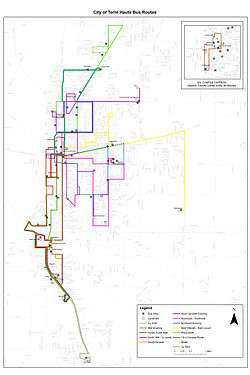Terre Haute Transit
Terre Haute Transit Utility or Terre Haute City Bus provides public transportation in the city of Terre Haute, Vigo County, Indiana
 | |
| Headquarters | 901 S. 14th Street |
|---|---|
| Locale | Terre Haute, IN |
| Service type | bus service, paratransit |
| Routes | 8 |
| Fleet | 11[1] |
| Annual ridership | 299,949 (2009)[2] |
| Fuel type | diesel, hybrid electric, gasoline[2] |
| Website | transit-department |
Services
Transportation is provided Monday through Saturday on 6 day and 3 evening fixed route lines along with two campus routes. One through the Indiana State University campus and another connecting to the Ivy Tech Main Campus.[3]

The city began operating bus service in 1964.[4]
Bus routes
Day
Evening
Fares and Passes
Fares

Regular: $1.75 - Children 5 & under ride free when accompanied by an adult.
Reduced: $.75 - for Senior Citizens/Disabled/Medicare Card Holders (ID Required) from 9:15am – 3:15pm & 7:00pm – 11:00pm
Passes
14-Ride Pass: $18.00 is available from the driver or at the Transit Office.
31-Day Pass: $40.00 - Unlimited rides for 31 days from the activation date. Available at the Transit Office at the new Multi-Modal Parking Garage.
Campus Agreements
Indiana State University students, faculty and staff are able to ride the bus for free by showing their university ID.[5] This is a result of a contract with the university where it pays the transit utility $110,000 per semester, which is matched with federal transit funds.[6]
Ivy Tech students and staff have the choice to ride the Terre Haute City Bus as well as the CampusTransit Shuttle Bus at no charge by showing a valid Ivy Tech ID.[7]
Fleet
Terre Haute transit uses a number of "Paratransit" vehicles manufactured by StarTrans. Fleet numbers range from 30-42 and a StarTrans Replica Trolley. Their fleet also includes two Azure Citibuses, hybrid type vehicles, that were entered service in May 2010.
References
- National Transit Database: Profile for Terre Haute Transit Utility
- Howard Greninger (4 February 2010). "Numbers up and down for buses". The Tribune-Star. Retrieved 2 March 2010.
- Terre Haute Transit Utility
- "City Assumes Bus Operation". Terre Haute Tribune. Terre Haute. 1964-09-22. p. 11 – via NewspaperARCHIVE.
- http://www.indstate.edu/sga/BusInitiative.htm
- http://tribstar.com/news/x295330145/Numbers-up-and-down-for-buses
- http://www.ivytech.edu/terrehaute/stories/campustransit.html